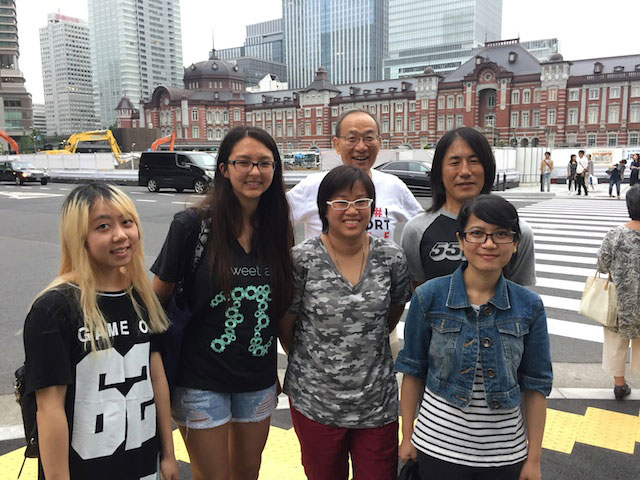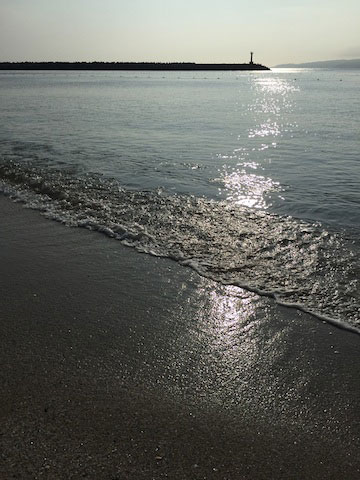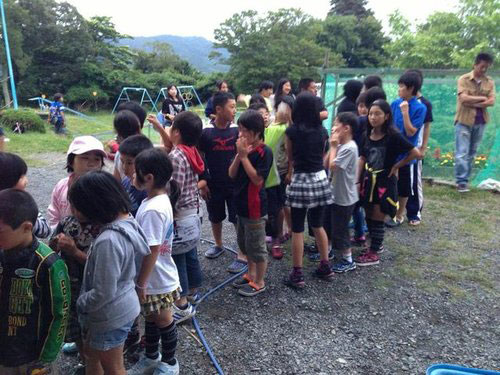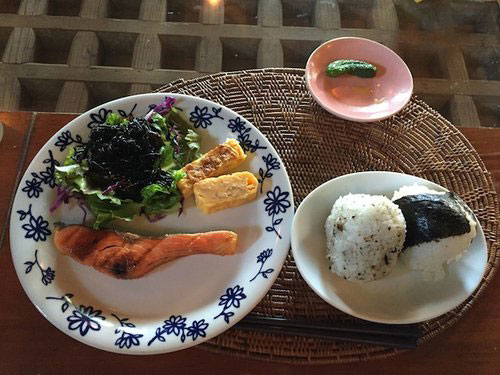Team Asunaro’s Tohoku Relief Project
Professor of anthropology at ICU,Etsuko Kato received a grant from the Japan ICU Foundation (JICUF) this spring. The ¥336,000 grant is being used to enable ICU students to participate in activities led by Team Asunaro, a volunteer group that has been contributing to recovery efforts in Tohoku after the Great East Japan Earthquake of 2011. Professor Kato has been actively recruiting Japanese students as well as exchange students from the University of California through the UC Tokyo Study Center (UCTSC) located on the ICU campus. Her goal has been to encourage the participation of students from diverse backgrounds. The JICUF grant covers such expenses as transportation, accommodation and sento (public bath house) fees.
The JICUF recently had the opportunity to interview Mr. Shimpei Suga, the leader of Team Asunaro, and Professor Kato. (After Mr. Suga completed the interview questions, Professor Kato reviewed and edited the answers.)

JICUF: Team Asunaro was founded in April 2011 by four individuals. Could you tell us a little bit about them?
Mr. Shimpei Suga (SS): Actually, Team Asunaro was originally formed as a group of French car enthusiasts. One member from Miyagi Prefecture was affected by the disaster, and all of us felt strongly about helping with recovery efforts. In June 2011, the four of us, who all had full-time jobs, got involved in relief efforts for the first time.
I was born in 1957 and studied mechanical engineering in college. I’ve been working for Sumitomo Heavy Industries since 1983 as a project manager, building paper pulp plants overseas. I’m currently working on a power plant project. When I was in graduate school, I went to Germany as an exchange student. After I joined the company, I had the chance to live in London for two years through the company’s study abroad program. As a student, I was looking beyond Japan and chose to work for Sumitomo Heavy Industries because it would allow me to work overseas. Then, in 2008, I had an assignment in New Jersey and lived there for a year. I think my natural interest in working outside Japan led me to involve foreign students in recovery efforts in Tohoku.
JICUF: Could you tell us how Team Asunaro became involved in relief efforts,and what kind of service activities you’re engaged in?
SS: I am from Kansai, and have long regretted the fact that I was unable to help at all during the Hanshin Earthquake. When I heard that the Oyama Family who ran a minshuku (Japanese-style B&B) in Kesennuma Oshima, where my family and I stayed twenty years ago, had been affected by the earthquake, I could not stand around. I decided to support relief efforts in Tohoku. Immediately after the earthquake, the situation in the affected areas was unclear, and there were no means of transportation to get there. I found an organization called Peace Boat on the Internet and joined their activity in Ishinomaki, Miyagi Prefecture, during Golden Week (end of April to early May). There was nothing at the disaster site, so I brought my own tent and 20 liters of water. I spent one week during my first visit, and the following month I joined another volunteer organization and visited Ishinomaki again. I was over 50 years old by then, and some of the relief activities that suited energetic young people began to feel physically and emotionally exhausting.

However, I wanted to continue volunteering in some way. By then I had been the leader of Team Asunaro for almost five years; it hit me that with its members whom I knew so well, I could organize long-term relief efforts. We carried out our first service project in June 2011. For the first time, we were able to assist relief efforts in Kesennuma, where the Oyama Family was living in temporary housing. My wish to support the area finally came true.
Team Asunaro’s activities have evolved over time. Up until the end of 2011, our focus was mainly on cleaning: shoveling out dirt, mud and debris that clogged gutters and inundated houses. As time passed, this type of work became an important source of income for people living in the affected areas. To avoid taking jobs away from the local people, we explored different ways to contribute to these communities. After consulting with the people in the area, we added two more service projects in March 2012.
1. Supporting the local fishery industry (seaweed, oyster, scallop, and sea squirt cultivation)
2. Providing emotional support to elderly people living in temporary housing (offering foot baths, organizing rakugo comedy performances, cleaning temporary housing, etc.)
In addition, we held a barbecue party at a local elementary school in the summer and gave out gifts to children at Christmas.
In mid-2013, we began to see a change in the profiles of our volunteers. Our core members, consisting of working adults, were gradually leaving. We felt strongly about continuing our monthly activities, and began to focus on recruiting students. As we explored the possibility of collaborating with student volunteer organizations, our partnership with Youth for 3.11materialized. Youth for 3.11 subsidized transportation expenses, which enabled numerous students to participate in relief efforts.
In addition, I met a UCTSC staff member at a cycling event, another interest of mine. She suggested that exchange students from the University of California could join Tohoku relief service activities and learn about Japan at the same time. Professor Miriam Wattles, the then Director of UCTSC, supported the idea, and a special information session on Team Asunaro for exchange students was held at ICU. In November 2013, the first group of international students joined our Tohoku relief project.
The transportation subsidy from Youth for 3.11 was to be discontinued in 2014, ande had to find a new sponsor, as student participation depended on it. Derek Yamashita, an ICU exchange student from the University of California, introduced us to the JICUF. We visited the Foundation at the end of 2013 to talk about our activities in the Tohoku region. Professors Miriam Wattles and Shaun Malarney submitted a proposal to the JICUF to provide transportation subsidy to Team Asunaro, and the JICUF decided to oblige for a year from June 2014.
JICUF: How did you meet Professor Kato?
SS: With the transportation subsidy from the JICUF ending in May 2015, we had to find another sponsor to continue our activities. Around this time, Ms. Carolyn Treadway, who studied at ICU in 1960-1961, visited Japan on an inspection tour of the disaster-affected areas in Tohoku. Prior to her journey, Carolyn contacted the JICUF and learned about the Team Asunaro program. She reached out to me, and we met at the ICU cafeteria on a cold rainy night in November 2014. I communicated our need to identify a new sponsor to continue to carry out our volunteer work. Carolyn was excited about our program and contacted Professor Kato, who at the time was the liaison for Actions of Concerned Teachers (ACT), a voluntary teacher’s network that aims to bridge liberal arts education with disaster relief efforts.

Professor Kato reached out to me immediately, and despite her busy schedule, started exploring various possibilities for us. Through ICU, Professor Kato learned that the new JICUF grant program would be launched in 2016 and applied for a grant. I was completely oblivious to Professor Kato’s kind efforts until she surprised me with the news that she had received a grant from the JICUF. I am truly grateful to her for championing our project, which is headed by an eccentric person (me!) with no direct connections to ICU. I fondly recall the joyous moment I learned that we’d received the grant, thanks to the support of the ICU community, which consists of people perhaps even more eccentric than myself!
Thus, our relationship with the JICUF began with Professor Wattles of UCTSC and evolved through our meetings with Carolyn, an exchange student at ICU 55 years ago, and Professor Kato. We are indebted to so many people who have supported us, and would like to take this opportunity to thank each and every one.
JICUF: Please tell us about the first Team Asunaro activity that ICU students participated in.
SS: ICU students first joined our service program in November 2013. You can read about it in the Team Asunaro blog.
JICUF: How many volunteers have participated in Team Asunaro’s service activities? What are their backgrounds? How do you recruit them?
SS: So far, we’ve had about 150 working adults and 120 students, a little less than 300 participants in total. Working adults are mostly salaried employees whom we met through social networks and various relief activities at disaster sites. Youth for 3.11 has been helping us recruit students volunteers since May 2013 when our partnership began. You can view their current recruitment advertisement here.
JICUF: What was the most memorable event in the past five years of Team Asunaro’s activities?
SS: I would say the barbecue party we held at Ayukawa Elementary School in July 2013. The children in the area were sick of eating fish, and the parents wanted to treat them to meat. We asked for donations from Team Asunaro members to purchase meat.

Teachers and parents were delighted to see the big smiles on the kids’ faces. One teacher said to us, “The excitement of these children is extraordinary. I have not seen this many kids gather and play outside since the disaster.” We also learned how children’s smiles make their families and the community happy. If you would like to learn more about that special day, please read articles 07/18 (1)and 07/18 (2) on our blog.
JICUF: We’d like to ask about the program for which the grant was awarded. The initial plan was for two ICU students to participate in volunteer activities every month over a 10-month period starting this April. Does this mean that 10 students have already participated as of August? Do you try to send one Japanese student and one international student each month? How do you select participants? Are there many applicants?
SS: In principle, the program is offered on a first-come, first-served basis. There is no selection process. However, we give priority to students from Asian countries who might not be financially privileged. As of the end of August, we have hosted four ICU students. Two more are planning to join our program in September, but the current numbers are not enough. I hope many people will read this article and consider participating.
JICUF: Could you tell us about Team Asunaro’s future activities and goals? Do you have any message to ICU alumni and donors in North America?
SS: The JICUF grant will enable us to continue with the Tohoku relief work until the end of March. During this period, we will carry out the following:
1. Team Asunaro’s weekend activities offer students opportunities to meet students from other universities within and beyond Japan, as well as non-student volunteers. By working and living together, they get to learn about different cultures. We would especially like to offer this opportunity to students from Asian countries who may otherwise not have the means to participate in such activities.
2. Through continuous support to the affected areas, Team Asunaro allows volunteers to witness the recovery efforts after the devastating disaster and helps them grasp the social, physical and emotional issues that the local people continue to face.

We will continue to recruit student volunteers with help from Professor Junko Ito, the current Director of UCTSC, her staff, and the ICU students who have already participated in our program. Professors Etsuko Kato, Takashi Nishio, and Tomiko Yamaguchi will also reach out to students who take their General Education course “Human, Society and Culture in Post-disaster Era.”
Although Team Asunaro’s activities are only held over weekends, working together with students from various countries presents a wonderful occasion to learn from one another and nurture tolerance. I believe terrorists around the world fear this type of exchange the most: the interaction of people based on respect and mutual understanding. While our activities are limited in scope, we’d like to keep sending this message to students. We would deeply appreciate your continued support.
JICUF: It is remarkable that you have run your program for five years.
SS: The reason why we’ve been able to continue our activity is because the people in the affected areas give us energy. When we head to Tohoku, we are pumped up and ready to help, and instead of returning to Tokyo drained of energy, we come back even more invigorated! It is just amazing.
Once we experience the positive energy that comes from a genuine connection with people, it stays with us and becomes rooted in our core. I believe that young people who’ve had such an experience can direct that positive energy to the community they live in. Maybe the joy of seeing this transformation in young people is what motivates me to go on.
JICUF:Thank you for taking your time to answer our questions and tell us about the wonderful service activities of Team Asunaro. We wish you and Team Asunaro all the best.
Every student who has participated in Team Asunaro service activities is required to submit a report to Professor Kato to share his or her experience.

Lauren Higa, an exchange student from UC Santa Barbara joined the Tohoku volunteer efforts this June. She says: “My time in Tohoku with Team Asunaro allowed me to better understand how the events of 2011 affected the area, and allowed me to engage with a part of Japan I would not otherwise have had the opportunity to. I am glad I got to do more than “pass through” the country and make at least a small, yet meaningful, impact.”
An overview of the activities Lauren participated in can be is here, and her report can be viewed here.
Waverly Runion, a student from UC Berkeley who participated in the service activities, gave us the following feedback: “Working with Team Asunaro was such an incredible experience for me. The attention paid to us by Shim-san really allowed me and the other volunteers to truly appreciate the three days of the program. He made sure we knew about the history, and introduced us to his friends in the area. A lot of times when people are involved with service work like this, they aren’t able to see the people that their work is affecting, so this was truly a unique experience and not one that I will forget anytime soon.“
Click here to learn more about the service activities in which Waverly took part. Her report can be viewed here.
Team Asunaro continues to call for volunteers to participate in their relief efforts. Students, alumni, and faculty members are all welcome to join and make a difference. For details, please contact the Team Leader Shimpei Suga via Email or Facebook.



